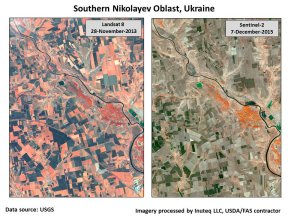Ukraine: 2016/17 Winter Grain Conditions
Because of excessive fall dryness, 11 percent of Ukraine’s sown winter-grain area for 2016/17 has failed to emerge, according to data from the Ministry of Agricultural Policy and Food (MAPF). The low level of crop emergence, combined with the sizable year-to-year drop in fall-sown area reported by the State Statistical Committee of Ukraine, suggests that the surviving 2016/17 winter-grain area could decrease by as much as 20 percent from last year.
Area Down for All Winter Grains
According to the State Statistical Committee, 2016/17 winter grains were sown on 7.47 million hectares (including an estimated 0.41 million hectares in Crimea not reported by the Committee), down 0.81 million hectares or 11 percent from last year. Wheat was planted on 6.28 million hectares (down 11 percent from last year), barley on 1.04 million (down 15 percent), and rye on 0.15 million (down 12 percent). The year-to-year decreases were highest in eastern and south-central Ukraine, the country’s main winter-wheat zone. Winter wheat accounts for about 98 percent of Ukraine’s total wheat output, and winter barley for about 40 percent of the total barley crop. Virtually all of the country’s rye is winter rye.
Fall Drought
Dryness prevailed from September through early November which impeded winter-grain sowing and contributed to this year’s lower area, which was about 10 percent below the MAPF forecast. The drought also had a noticeable negative impact on crop emergence and establishment. Satellite-derived vegetation indices from early November and higher-resolution imagery from early December both capture this season’s reduced area and poor conditions compared to the 2014/15 crop, which benefited from favorable establishment weather during the autumn of 2013. (See the November Commodity Intelligence Report for a discussion of the fall establishment conditions.)
Poor Emergence
 The mid-February MAPF report citing 89-percent winter-crop emergence confirmed the imagery-based evidence of poor winter-crop establishment. While the 11-percent failure to emerge is higher than average, it is substantially lower than the 19-percent emergence failure reported for the 2012/13 crop. Moreover, surface moisture for the current crop was replenished over the winter and it’s likely that a small portion of the winter crops that have not yet sprouted will eventually emerge as spring weather approaches and temperatures climb. The mid-February MAPF report citing 89-percent winter-crop emergence confirmed the imagery-based evidence of poor winter-crop establishment. While the 11-percent failure to emerge is higher than average, it is substantially lower than the 19-percent emergence failure reported for the 2012/13 crop. Moreover, surface moisture for the current crop was replenished over the winter and it’s likely that a small portion of the winter crops that have not yet sprouted will eventually emerge as spring weather approaches and temperatures climb.
Retreating Snow
Above-freezing temperatures during February, including several unusually warm days in the middle of the month, accelerated the melting of Ukraine’s remaining snow cover, leaving winter crops vulnerable to frost damage in the event of a sudden and sharp drop in temperatures. In recent years, however, the damage caused by frost or other cold-related events has been relatively low. The last occurrence of significant widespread winter losses was in February 2003, when a persistent ice crust smothered winter crops, destroying nearly two-thirds of the country’s wheat, over 80 percent of the winter barley, and over 90 percent of the winter rape. Fall drought typically poses the most significant threat to Ukraine’s winter crops.
The valuable contribution of Denys Sobolev, agricultural specialist at the USDA Office of Agricultural Affairs in Kyiv, is gratefully acknowledged. Current USDA area and production estimates for grains and other agricultural commodities are available on IPAD's Agricultural Production page or at PSD Online. Initial USDA estimates of 2016/17 crop production will be published on May 10, 2016.
Visit Crop Explorer http://www.pecad.fas.usda.gov/cropexplorer/
|

